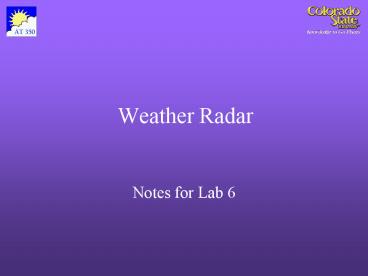Weather Radar - PowerPoint PPT Presentation
1 / 9
Title:
Weather Radar
Description:
Weather Radar. Notes for Lab 6. RADAR. RAdio Detection And Ranging ... Radar measures the intensity of the returned signal, the frequency of the ... – PowerPoint PPT presentation
Number of Views:3011
Avg rating:3.0/5.0
Title: Weather Radar
1
Weather Radar
- Notes for Lab 6
2
RADAR
- RAdio Detection And Ranging
- Transmits a microwave into the atmosphere and
measures the return power - 10, 5, 3 cm typical
- Size chosen depends on use
3
Radar Parts
Antenna
Transmitter
Transmit/Receive Switch
Receiver
Display
4
How does radar work
- Pulse of microwave energy sent out (emitted from
antenna to parabolic dish reflector), dish
focuses energy into beam - Beam travels through atmosphere
- If the beam hits an object, then some of the
energy is reflected back to the radar - Return power measured
- Data processed to a visual display
5
Energy Return
- Radar measures the intensity of the returned
signal, the frequency of the returned signal, and
the elapsed time from the transmission of the
pulse - Energy beam travels at the speed of light
- Knowledge of the elapsed time allows the
computation of the distance from the radar site - Frequency uses doppler shift to determine movement
6
Return Power
- Only a fraction of the emitted energy gets
returned from reflection - amplified and measured in decibels (dbz),
Reflectivity - 1dbz 10 log(p2/p1)
- p2 power received at radar, varies
- Reflectivity is dependent upon the size of the
object - In meteorology, the objects are precipitation
particles - A plotted region of high reflectivity is called
an echo
7
Reflectivity Dependence
- The return power (reflected beam) is dependent on
the number of particles present, and the size of
the particles - Particle diameter6 dependence
- Number1 dependence
- Larger drops lead to larger reflectivities echoes
- Reflectivity mostly based on particle size
8
General Reflectivities
- Drizzle 20 - 25 dBz
- Light rain 25 35 dBz
- Heavy Rain 35 50 dBz
- Thunderstorm Heaviest Rainfall gt50 dBz
- Light Snowfall 15 25 dBz
- Heavy Snowfall 25 35 dBz
9
Rainfall Rates
- How much rain falls to the surface in a given
hour - Rinches/hour
- a and b are constants
- Higher reflectivity generally corresponds to
higher rainfall rates































